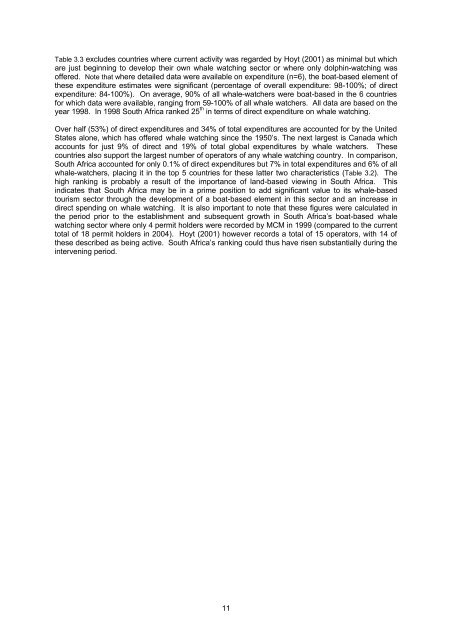Download PDF (2.5MB) - Anchor Environmental
Download PDF (2.5MB) - Anchor Environmental
Download PDF (2.5MB) - Anchor Environmental
Create successful ePaper yourself
Turn your PDF publications into a flip-book with our unique Google optimized e-Paper software.
Table 3.3 excludes countries where current activity was regarded by Hoyt (2001) as minimal but which<br />
are just beginning to develop their own whale watching sector or where only dolphin-watching was<br />
offered. Note that where detailed data were available on expenditure (n=6), the boat-based element of<br />
these expenditure estimates were significant (percentage of overall expenditure: 98-100%; of direct<br />
expenditure: 84-100%). On average, 90% of all whale-watchers were boat-based in the 6 countries<br />
for which data were available, ranging from 59-100% of all whale watchers. All data are based on the<br />
year 1998. In 1998 South Africa ranked 25 th in terms of direct expenditure on whale watching.<br />
Over half (53%) of direct expenditures and 34% of total expenditures are accounted for by the United<br />
States alone, which has offered whale watching since the 1950’s. The next largest is Canada which<br />
accounts for just 9% of direct and 19% of total global expenditures by whale watchers. These<br />
countries also support the largest number of operators of any whale watching country. In comparison,<br />
South Africa accounted for only 0.1% of direct expenditures but 7% in total expenditures and 6% of all<br />
whale-watchers, placing it in the top 5 countries for these latter two characteristics (Table 3.2). The<br />
high ranking is probably a result of the importance of land-based viewing in South Africa. This<br />
indicates that South Africa may be in a prime position to add significant value to its whale-based<br />
tourism sector through the development of a boat-based element in this sector and an increase in<br />
direct spending on whale watching. It is also important to note that these figures were calculated in<br />
the period prior to the establishment and subsequent growth in South Africa’s boat-based whale<br />
watching sector where only 4 permit holders were recorded by MCM in 1999 (compared to the current<br />
total of 18 permit holders in 2004). Hoyt (2001) however records a total of 15 operators, with 14 of<br />
these described as being active. South Africa’s ranking could thus have risen substantially during the<br />
intervening period.<br />
11
















